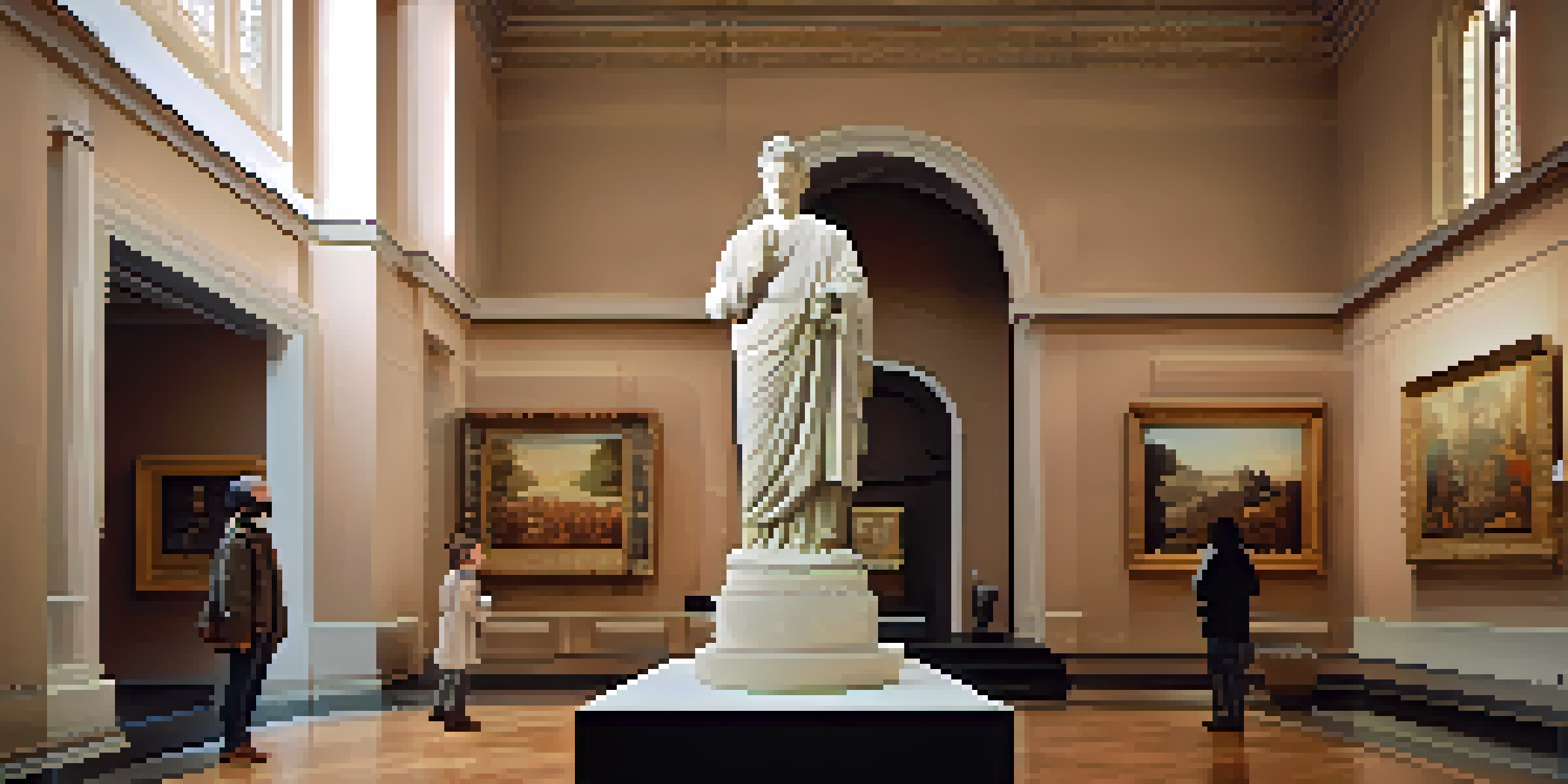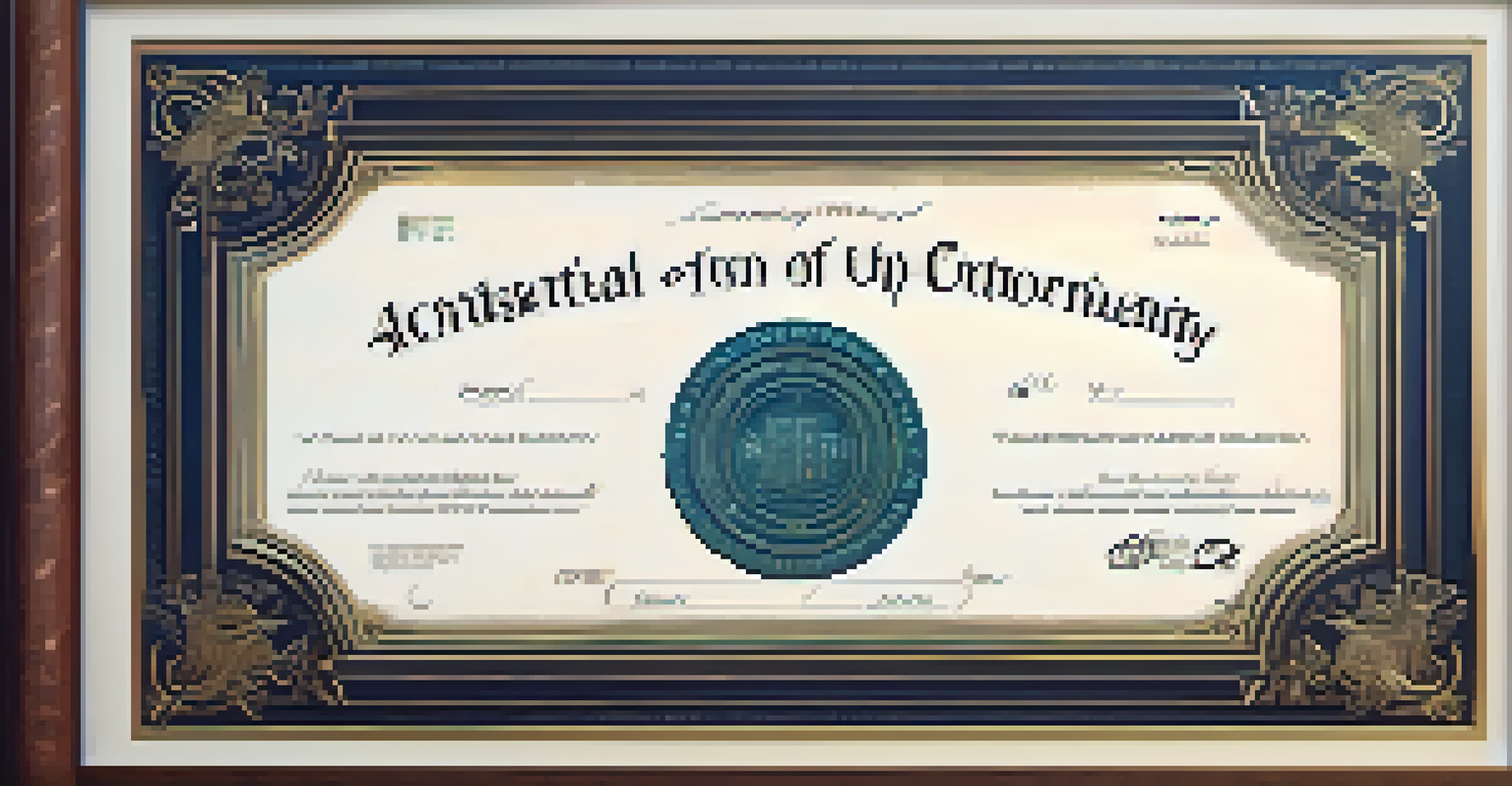NFTs as Digital Certificates for Historical Artifacts

Understanding NFTs and Their Role in Digital Ownership
NFTs, or non-fungible tokens, are unique digital assets verified using blockchain technology. Unlike cryptocurrencies, which are interchangeable, NFTs represent ownership of a distinct item, making them particularly valuable for art and collectibles. This uniqueness is crucial when it comes to historical artifacts, as it helps ensure that the provenance— or history of ownership— is accurately documented and preserved.
The future is already here — it's just not very evenly distributed.
Imagine holding a one-of-a-kind baseball card that only you own, while everyone else has replicas. NFTs create this same sense of exclusivity in the digital realm, providing a way to claim ownership over historical artifacts. This technology can revolutionize how we view ownership and authenticity in the art world, bridging the gap between traditional artifacts and modern technology.
By utilizing NFTs, museums and collectors can provide a digital certificate of authenticity for each artifact. This not only increases transparency but also enhances the value of the artifact by proving its legitimacy in a way that is easily accessible and verifiable.
The Provenance Challenge in Historical Artifacts
One of the biggest challenges in the art world is establishing provenance. Provenance refers to the history of ownership and authenticity of an artwork or artifact, which helps to determine value and significance. Without clear provenance, an artifact's worth can be questioned, leading to disputes over ownership and authenticity.

Using NFTs as digital certificates can help solve this issue by providing a verifiable chain of ownership. Each time an artifact changes hands, the transaction is recorded on the blockchain, creating an immutable record. This means that future owners can trace the artifact’s history back to its origin, similar to how a family heirloom might be passed down with a detailed history.
NFTs Enhance Digital Ownership
NFTs provide a unique way to establish and verify ownership of digital artifacts, revolutionizing the art world.
For example, if a historical manuscript is sold, the NFT would carry with it details of its previous owners, exhibitions, and even conservation efforts. This level of transparency not only enhances the artifact's value but also builds trust in the market.
Enhancing Accessibility to Historical Artifacts
While traditional artifacts are often locked away in museums, NFTs can help democratize access to historical art. Digital representations of these artifacts can be made available to the public, allowing people to explore and appreciate them from anywhere in the world. This is especially significant for artifacts that are too fragile to be displayed or that reside in private collections.
Art is not freedom from discipline, but disciplined freedom.
Consider a famous painting that is rarely exhibited due to its age and fragility. By creating an NFT of the work, museums can provide a high-quality digital replica that people can view online. This way, the artwork’s beauty and historical significance can be appreciated without the risks associated with physical display.
This increased accessibility not only enriches cultural knowledge but also inspires future generations to learn about history. People are more likely to engage with and appreciate artifacts when they can easily access them through digital means.
Preserving Cultural Heritage with NFTs
Cultural heritage is often at risk due to factors like aging, environmental conditions, and even conflict. NFTs can play a crucial role in preserving this heritage by creating digital records of artifacts. These records can be maintained even if the physical items deteriorate or are lost, serving as a backup of our shared history.
Imagine a centuries-old statue that is at risk of being damaged. By creating an NFT representing the statue, detailed images, descriptions, and historical context can be preserved digitally. This ensures that future generations can still connect with the artifact, even if the original is no longer intact.
Provenance Tracking with Blockchain
Using NFTs enables a transparent and verifiable record of an artifact's ownership history, enhancing trust in the art market.
Moreover, NFTs can facilitate international collaboration for preserving artifacts. Different institutions can work together to create a comprehensive digital archive, ensuring that cultural heritage is safeguarded across borders.
The Economic Impact of NFTs on the Art Market
The introduction of NFTs into the art market is creating new economic opportunities for artists and collectors alike. By providing a mechanism for digital ownership, artists can sell their work as NFTs, opening up a new revenue stream. This shift is particularly beneficial for emerging artists who may struggle to gain visibility in traditional galleries.
For collectors, NFTs can transform how they invest in art. Instead of solely relying on physical pieces, collectors can diversify their portfolios by investing in digital art and artifacts. This can lead to increased demand for historical artifacts as NFTs, potentially driving up their value as more people recognize their importance.
As the market evolves, we may see new business models emerge that leverage NFTs, such as fractional ownership, where multiple investors can own a share of a valuable artifact represented as an NFT. This could make high-value artifacts more accessible to a broader audience.
Ethical Considerations in Using NFTs for Artifacts
While the potential of NFTs is exciting, ethical considerations must be addressed. Questions around copyright, ownership rights, and the environmental impact of blockchain technology are crucial to consider. Artists and artifact owners need to ensure they have the right to tokenize their work before creating NFTs.
Additionally, the environmental concerns associated with certain blockchain technologies—particularly those that rely on energy-intensive proof-of-work systems—must be taken seriously. The art community is increasingly aware of these issues, prompting discussions on how to create more sustainable methods for minting NFTs.
Accessibility and Preservation
NFTs democratize access to historical artifacts while preserving their digital records for future generations.
It's important for stakeholders in the art world to engage in these conversations to develop best practices. By prioritizing ethical considerations, we can work towards a future where NFTs contribute positively to the preservation and appreciation of historical artifacts.
The Future of NFTs in Preserving Historical Artifacts
The future of NFTs in preserving historical artifacts looks bright. As technology continues to evolve, we can expect to see more innovative applications of NFTs in the art world. From virtual exhibitions to interactive experiences, the possibilities are endless.
Imagine visiting a virtual museum where you can explore historical artifacts through NFTs, complete with augmented reality features that allow you to see the artifacts in their original context. This type of experience could revolutionize how people engage with history, making it more immersive and educational.

As more organizations recognize the benefits of NFTs, we may see wider adoption across museums, galleries, and even private collectors. By embracing this technology, we can help ensure that our cultural heritage is preserved and appreciated for generations to come.